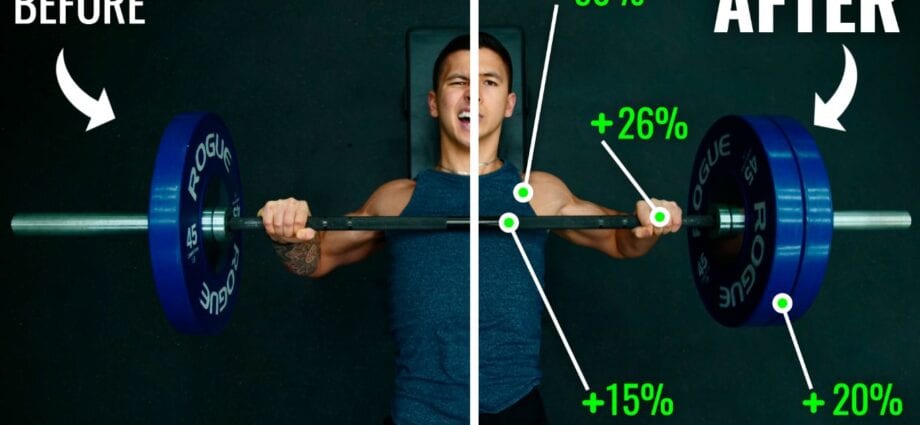Contents
How to increase weight on the bench press
If you’re the type of guy who thinks of the bench press as just an exercise to develop your pectoral muscles, it’s time to think again.
Author: Matt Rhodes
When performed correctly, the bench press engages the muscles of the whole body, developing strength and muscularity in the same way as when performing several exercises. It can be exactly the kind of exercise that, if performed with sufficient weight, will turn all heads in the gym in your direction. The whole trick of getting the most out of this traditional exercise is to purposefully increase the weight of the bench press – a task that may not be enough to do with intuition.
Each major muscle group in your body plays a role in performing the bench press correctly, especially when you start using serious weights. And the main thing is that you can push large weights, regardless of whether you have naturally powerful breasts or not. You just need to make an effort to use all the accessory muscles involved in the bench press. Once you build this “support” of synergistic muscles, you can handle much greater loads than ever before, which, in turn, will allow you to build mass faster.
We will explain the role each of these accessory muscle groups plays and suggest the best strategy for combining them into a single mechanism that will increase bench press weight and turn you into one large and powerful barbell press machine.
Home
To increase the initial kick impulse from the chest, you will have to train your legs, and very hard. This may sound counterintuitive, but the lower body serves as a kind of bench press power base. At the beginning of a properly performed bench press, your body is like a compressed spring, all the potential energy of which is concentrated in the legs. If you fail to train your lower body enough to “open the spring” with full force, you will sacrifice a significant portion of the weight that you might otherwise have squeezed out.
To be able to build such a foundation, you will have to devote one full training day to developing your lower body. You will squat, deadlift, and prepare your leg muscles to initiate and support the bench press. These activities will not only strengthen your legs, but also engage your core and lower back muscles.
Basis
Although you support the bar with your arms and chest during the press, it is your back that holds the rest of your body in position while you do the exercise. As soon as the barbell starts to move upward thanks to the strength of your legs, the lats come into play, helping to perform the push and accelerate the movement of the bar towards the midpoint of the amplitude of the press.
The exercises in this program will develop your back at every angle to provide the required load and> intensity, which in turn will add mass and width and improve your bench press. In addition to doing deadlifts (which, by the way, is a grossly underestimated upper back exercise) aimed at developing your lower body, you will do a couple of latissimus exercises: the T-bar row and the incline chest row. … And another excellent exercise for the upper body – pull-ups – will “finish off” the back.
Stability
Now that your barbell is moving towards the top, you should stabilize it. You will have a sense of your own rhythm when everything happens as it should, at any point in the range of motion. As soon as you feel this, try to maintain the achieved balance; it will help you maintain an optimal position and prevent injury.
The key here is shoulder strength, not only for pushing up large weights, but also for protecting those muscles that complete the press; and if the shoulders are strong, each heavy rep will feel like the exercise is being done correctly.
Conversely, if your shoulders are not strong enough to hold heavy weights in a stable position while pressing, they will be vulnerable to various types of injury.
With this program, you will only do one exercise to strengthen your shoulders, but it is the most effective exercise known today: the standing barbell press. We know this is a fitness cliché, but when it comes to overall shoulder size and strength, this exercise is more effective than any other exercise.
Observe the technique of performing the exercise (the movement of the bar should end above and slightly behind the head) and you will see that the weight of your bar will skyrocket in just a few weeks.
Ending
From about the middle of the amplitude of the bench press, the triceps are involved in the execution. These are the muscles that push the bar to its final position, so the strength of the triceps – especially the long head – is a must for a successful bench press.
When you work out the long head of the triceps, you will feel tension near your elbows. With this program, you will “attack” this strategically important anatomical element with the narrow grip bench press and the French bench press. You can add a French bench press to your program to aesthetically balance this muscle group, but remember that the long head is the one that provides the power you need to push large weights.
Your Cool Bench Press Plan
Your first step involves determining the maximum bar weight for one repetition (1RM). If you are training on your own and do not feel safe doing this exercise, you can use the following formula to calculate the approximate 1RM:
Program
Day 1: Upper body
3 approach to 10, 5, 3 repetitions
Day 2: Lower body
Day 3: Accessory muscles
3 approach to 10 repetitions










